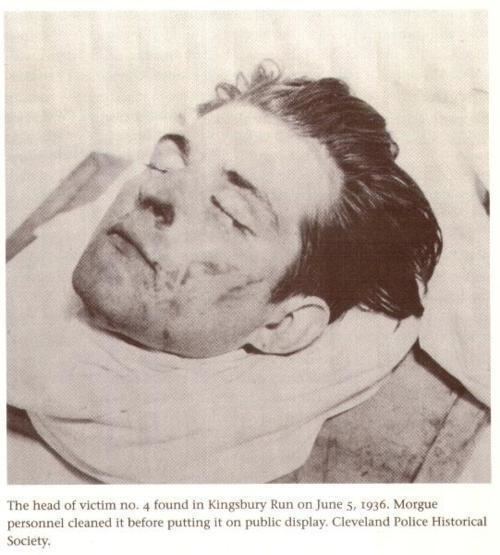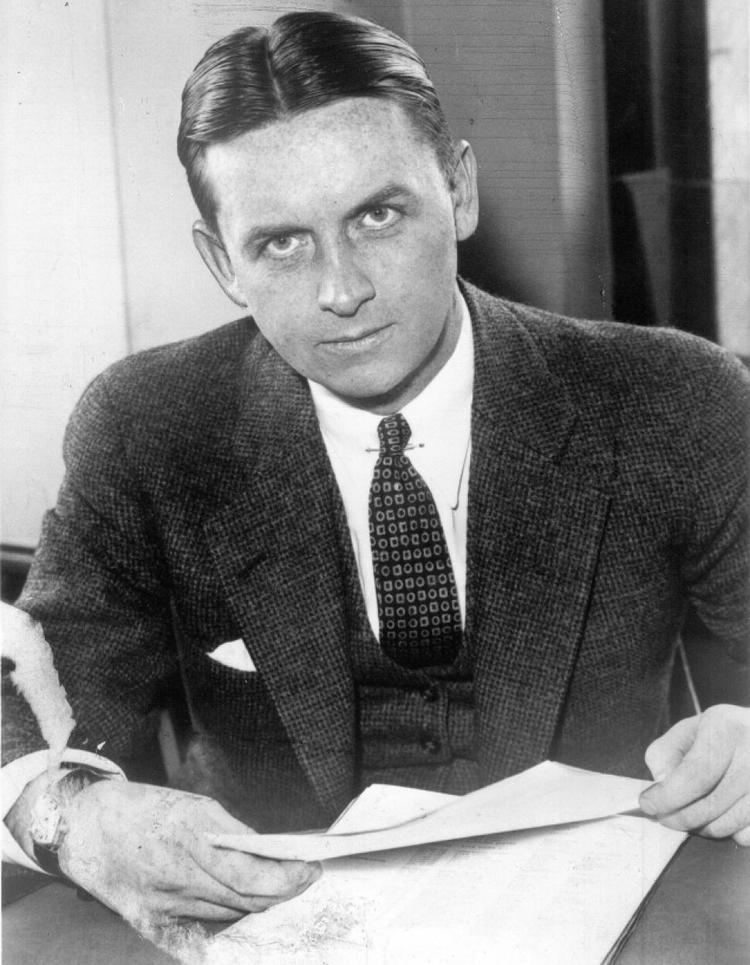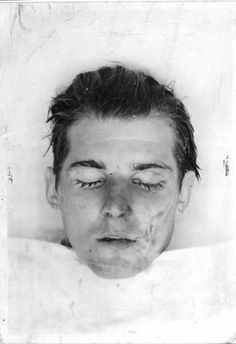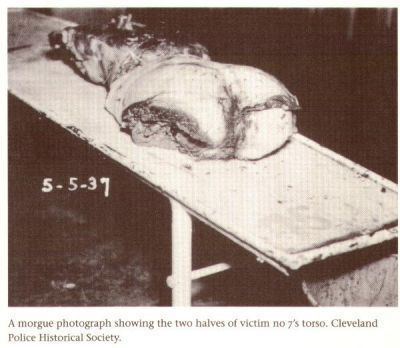Victims 12–20 | ||
 | ||
Similar Eliot Ness, Richard Cottingham, Axeman of New Orleans, William Heirens, Servant Girl Annihilator | ||
10 serial killers that were never caught
The Cleveland Torso Murderer (also known as the Mad Butcher of Kingsbury Run) was an unidentified serial killer who killed and dismembered at least 12 victims in the Cleveland area in the 1930s.
Contents
- 10 serial killers that were never caught
- Murders
- Victims
- Possible victims
- Suspects
- In popular culture
- References

Murders

The official number of murders attributed to the Cleveland Torso Murderer is twelve, although recent research has shown there are as many as twenty. The twelve victims were killed between 1935 and 1938. But some, including lead Cleveland Detective Peter Merylo, believe that there may have been 13 or more victims in the Cleveland, Pittsburgh, and Youngstown, Ohio, areas between the 1920s and 1950s. Two strong candidates for addition to the initial list of those killed are the unknown victim nicknamed the "Lady of the Lake", found on September 5, 1934, and Robert Robertson, found on July 22, 1950.

The victims of the Cleveland Torso Murderer were usually drifters whose identities were never determined, although there were a few exceptions (victims numbers 2, 3, and 8 were identified as Edward Andrassy, Florence Polillo, and possibly Rose Wallace, respectively). Invariably, all the victims, male and female, appeared to hail from the lower class of society—easy prey in Depression-era Cleveland. Many were known as "working poor", who had nowhere else to live but the ramshackle shanty towns in the area known as the Cleveland Flats.

The Torso Murderer always beheaded and often dismembered his victims, sometimes also cutting the torso in half. In many cases the cause of death was the decapitation or dismemberment itself. Most of the male victims were castrated, and some victims showed evidence of chemical treatment being applied to their bodies. Many of the victims were found after a considerable period of time following their deaths, sometimes a year or more. This made identification nearly impossible, especially since the heads were often not found.

During the time of the "official" murders, Eliot Ness held the position of Public Safety Director of Cleveland, a position with authority over the police department and ancillary services, including the fire department. While Ness had little to do with the investigation, his posthumous reputation as leader of The Untouchables has made him an irresistible character in modern "torso murder" lore. Ness did contribute to the arrest and interrogation of one of the prime suspects, Dr. Francis E. Sweeney, as well as the demolition and burning of the Kingsbury Run, from which the killer took his victims. At one point in time, the killer even taunted Ness by placing the remains of two victims in full view of his office in city hall.
Victims

Most researchers consider there to be twelve definite victims, although new evidence suggests a woman dubbed "The Lady of the Lake" could be included. Only two victims were positively identified; the other ten were six John Does and four Jane Does.
^ †: The victim, who was estimated to be in his mid twenties, had six unusual tattoos on his body. One included the names "Helen and Paul" and another had the initials "W.C.G." His undershorts bore a laundry mark indicating the owner's initials were J.D. Despite morgue and death mask inspections by thousands of Cleveland citizens in the summer of 1936 at the Great Lakes Exposition, the victim known as the "tattooed man" was never identified.
^ ‡: Victim was possibly “Rose Wallace”. Dental work was considered a close match by police and her son (who said he was certain that the victim was his mother). Exact identification could not be achieved because the dentist who carried out the work had died years before. Doubts remained, because the body was estimated to have been dead for a year whereas Wallace had only been missing for 10 months.
Edward Andrassy was buried in St Mary Cemetery, Cleveland, Ohio; Florence Pollila is buried in Pennsylvania Five of the John/Jane Does {"Lady of the Lake"; and victims John Doe #1; John Doe# 2; John Doe # IV; Jane Doe #5} were buried in Potter's Field Section of Highland Park Cemetery, Highland Park, Cuyahoga County, Ohio. Jane Doe VI/Rose Wallace ? remains were donated to Western Reserve University Medical School
Possible victims
Several non-canonical victims are commonly discussed in connection with the Torso Murderer. The first was nicknamed the "Lady of the Lake" and was found near Euclid Beach on the Lake Erie shore on September 5, 1934, at virtually the same spot as canonical victim number 7. Some researchers of the Torso Murderer's victims count the "Lady of the Lake" as victim number 1, or "Victim Zero".
The headless body of an unidentified male was found in a boxcar in New Castle, Pennsylvania, on July 1, 1936. Three headless victims were found in boxcars near McKees Rocks, Pennsylvania, on May 3, 1940. All bore similar injuries to those inflicted by the Cleveland killer. Dismembered bodies were also found in the swamps near New Castle between the years 1921 and 1934 and between 1939 and 1942. In September 1940 an article in the New Castle News refers to the killer as "The Murder Swamp Killer". The almost identical similarities between the victims in New Castle to those in Cleveland, Ohio, coupled with the similarities between New Castle's Murder Swamp and Cleveland's Kingsbury Run, both of which were directly connected by a Baltimore and Ohio Railroad line, were enough to convince Cleveland Detective Peter Merylo that the New Castle murders were the work of the "Mad Butcher of Kingsbury Run". Merylo was convinced the connection was the railroad that ran twice a day between the two cities; he often rode the rails undercover looking for clues to the killer's identity.
On July 22, 1950, the body of 41-year-old Robert Robertson was found at a business at 2138 Davenport Avenue in Cleveland. Police believed he had been dead six to eight weeks and appeared to have been intentionally decapitated. His death appeared to fit the profile of other victims: He was estranged from his family, had an arrest record and a drinking problem, and was on the fringes of society. Despite widespread newspaper coverage linking the murder to the crimes in the 1930s, detectives investigating Robertson's death treated it as an isolated crime.
In 1939 the "Torso Killer" claimed to have killed a victim in Los Angeles, California. An investigation uncovered animal bones.
Suspects
On August 24, 1939, a Cleveland resident named Frank Dolezal, 52, was arrested as a suspect in Florence Polillo's murder; he later died under suspicious circumstances in the Cuyahoga County jail. After his death it was discovered that he had suffered six broken ribs—injuries his friends say he did not have when arrested by Sheriff Martin L. O'Donnell some six weeks prior. Most researchers believe that no evidence exists that Dolezal was involved in the murders, although at one time he did admit killing Florence Polillo in self-defense. Before his death, he recanted his confession and recanted two others as well, saying he had been beaten until he confessed.
Most investigators consider the last canonical murder to have been in 1938. One suspected individual was Dr. Francis E. Sweeney. Sweeney was a veteran of World War I who was assigned in a medical unit that conducted amputations and patching in the field. Sweeney was later personally interviewed by Eliot Ness, who oversaw the official investigation into the killings in his capacity as Cleveland's Safety Director. During this interrogation, Sweeney is said to have "failed to pass" two very early polygraph machine tests. Both tests were administered by polygraph expert Leonard Keeler, who told Ness he had his man. Nevertheless, Ness apparently felt there was little chance of obtaining a successful prosecution of the doctor, especially as he was the first cousin of one of Ness's political opponents, Congressman Martin L. Sweeney, who had hounded Ness publicly about his failure to catch the killer. {Congressman Sweeney was also related by marriage to Sherriff O'Donnell}. After Dr. Sweeney committed himself, there were no more leads or connections that police could assign to him as a possible suspect. From his hospital confinement, threatening postcards with Sweeney's name mocked and harassed Ness and his family into the 1950s. Sweeney died in a veterans' hospital at Dayton in 1964.
In 1997, another theory postulated that there may have been no single Butcher of Kingsbury Run because the murders could have been committed by different people. This was based on the assumption that the autopsy results were inconclusive. First, Cuyahoga County Coroner Arthur J. Pearce may have been inconsistent in his analysis as to whether the cuts on the bodies were expert or slapdash. Second, his successor, Samuel Gerber, who began to enjoy press attention from his involvement in such cases as the Sam Sheppard murder trial, garnered a reputation for sensational theories. Therefore, the only thing known for certain was that all the murder victims were dismembered.
